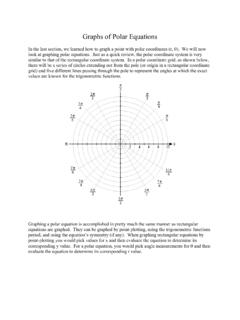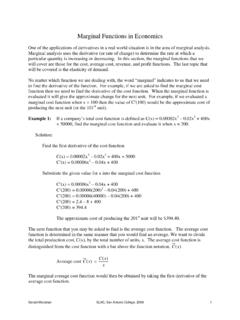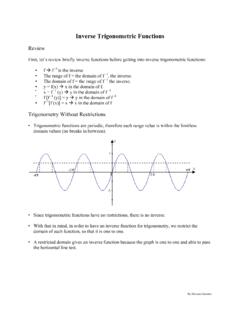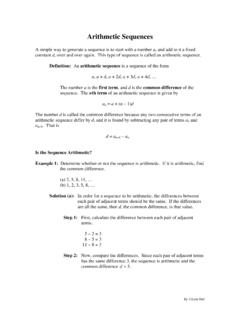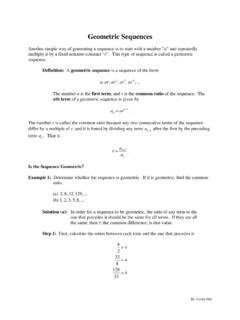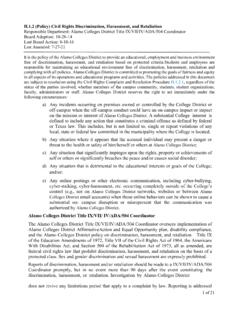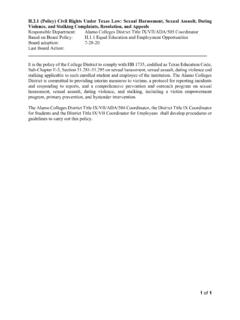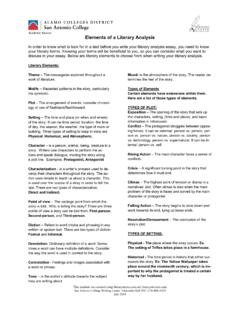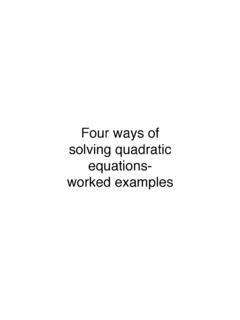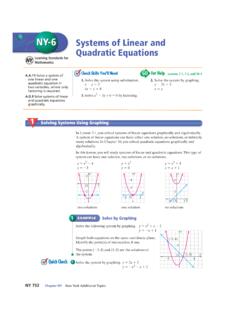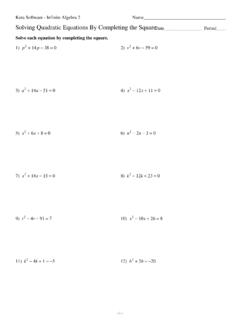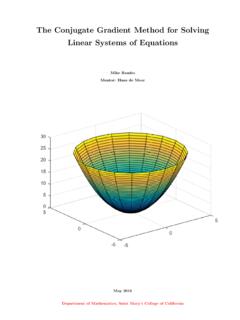Transcription of Exponential and Logarithmic Equations
1 Exponential and Logarithmic Equations In this section, we solve Equations that involve Exponential or Logarithmic Equations . The techniques discussed here will be used in the next section for solving applied problems. Exponential Equations : An Exponential equation is one in which the variable occurs in the exponent. For example, 31x1= The variable x presents a difficulty because it is in the exponent. We can solve such an equation using the guidelines below. Guidelines for Solving Exponential Equations : 1. Isolate the Exponential expression on one side of the equation. 2. Take the logarithm of each side, then use the Laws of Logarithms to bring down the exponent. 3. Solve for the variable. Example 1: Find the solution of the Exponential equation, correct to four decimal places.
2 (a) 31 1x= (b) 34611xe+ = (c) 235xx+= (d) 212 0xxee+ = Solution (a): To solve this equation we will use the guidelines for solving Exponential Equations given above. Step 1: The first step in solving an Exponential equation is to isolate the Exponential expression on one side of the equation. Our equation 3x = 11 is already in this form so we can move on to the next step. By: Crystal Hull Example 1 (Continued): Step 2: The next step in solving an Exponential equation is to take the logarithm of both sides, and then use the Laws of Logarithms to bring down the exponent.
3 Note that we use the common logarithm because our calculator can evaluate it, but we could have chosen to use any logarithm we like. Take the logarithm of each side Bring down the expntone311log 3log11 log 3 log11xxx=== Step 3: The final step in solving an Exponential equation is the solve for the variable. x Divide both sides by log 3 Use a calcula rtolog 3 log11g11 log lo == xx 11 Step 4: We can check our answer by substituting x = into the original equation and using a calculator. We get Solution (b): Again we will follow the guidelines for solving Exponential Equations .
4 Step 1: Isolate the Exponential expression on one side of the equation: 343461117 xxee++ ==Add 6 to both sides Take the natural logarithm of each side Bring down the exponent Step 2: Since the base of our Exponential term is , we choose to take e the natural logarithm of both sides of the equation. Then use the Laws of Logarithms to bring down the exponent. ()343417lnln17 34 lnlog17xxeexe++==+=By: Crystal Hull Example 1 (Continued): Step 3: Solve for the variable. ()ln1 Subtract 4 from both sidesDivide both sides by 3 Use a calculatore=34 lnln 1734 ln17 3ln17 4 ln174 xexxxx+=+== = Step 4: Check the answer by substituting x = into the original equation and using a calculator.
5 ()3 + Solution (c): This problem is different from the previous two in that it has an Exponential expression on both sides of the equation. We can still use the guidelines for solving Exponential Equations though. Step 1: Our first step is to isolate the Exponential expression on one side of the equation. Since our equation, 3x+2 = 5x, has two Exponential expression, we want to make sure each expression is isolated on different sides of the equals sign. This is the case, and so we move on to the next step. Step 2: Next we will take the logarithm of both sides. For this problem we have two exponents to bring down using the Laws of Logarithms.
6 ()22 Tak35log 3log 5 2log Br3log5xxxxxx++==+=e the logarithm of each sideing down the exponentsBy: Crystal Hull Example 1 (Continued): Step 3: Now we solve for the variable. ()()()Distribute Rearrange termsFactor out Divide both sidesx() by log 3 - log 5 Use a calcu olat r2 log 3log 5log 3 2 log 3log 5 log 3log 52 log 3 log 3 log 52 log3 2log3 log 3 log 5xxxxxxxx+=+= = = = x Step 4: Check the answer by substituting x = into the original equation and using a calculator. + Solution (d): Step 1: In this problem our equation, e2x + ex 12 = 0, is quadratic . We can isolate the Exponential term by factoring.
7 ()()()22 12 0 12 0 430 4 0 or3 0 Ze e4 3xxxxxxxxxxLaw of ExponentsFactor (a quadratic in )ro-Product Propertyxeeeeeeeee+ =+ =+ =+= == =eTake the logarithm of each side Bring down the exponent Step 2: Since we now have two Equations , we have a possibility of two solutions. We should perform the rest of our steps on each equation. Notice though that ex = 4 has no solution because ex > 0 for all x, so we can discard this equation. Now we will take the natural logarithm of both sides of ex = 3, and use the Laws of Logarithms to bring down the exponent. 3lnln 3 lnln 3xxeexe=== By: Crystal Hull Example 1 (Continued): Step 3: Now we solve for the variable.
8 Lnln 3ln 3 xexx ==ln1 Use a calculatore= Step 4: Check the answer by substituting x = into the original equation and using a calculator. We get ()2 0ee+ Logarithmic Equations : A Logarithmic equation is one in which a logarithm of the variable occurs. For example ()7log317x = We can solve this type of equation using the following guidelines. Guidelines for Solving Logarithmic Equations : 1. Isolate the Logarithmic term on one side of the equation; you may need to first combine the Logarithmic terms. 2. Write the equation in Exponential form (or raise the base to each side of the equation) 3. Solve for the variable.
9 Example 2: Solve the Logarithmic Equations for x. (a) () 7log317x = (b) ()10 ln314x++= (c) ()()55log4log22xx + += (d) ()(ln2ln)xx+= By: Crystal Hull Example 2 (Continued): Solution (a): To solve this equation we will use the guidelines for solving Logarithmic Equations given above. Step 1: The first step in solving a Logarithmic equation is to isolate the Logarithmic term on one side of the equation. Our equation log 7 (x 3) = 17 is already in this form so we can move on to the next step.
10 Step 2: The next step in solving a Logarithmic equation is to write the equation in Exponential form, using the definition of the Logarithmic function. logyaxyax= = ()177log31773xx = = Step 3: The final step in solving a Logarithmic equation is the solve for the variable. 171773 7 +3 xx= =Add 3 to both sides Step 4: Check your answer. If x = 717 + 3, we get ()()()171777log733log 717+ == Solution (b): Again we will follow the guidelines for solving Logarithmic Equations .
